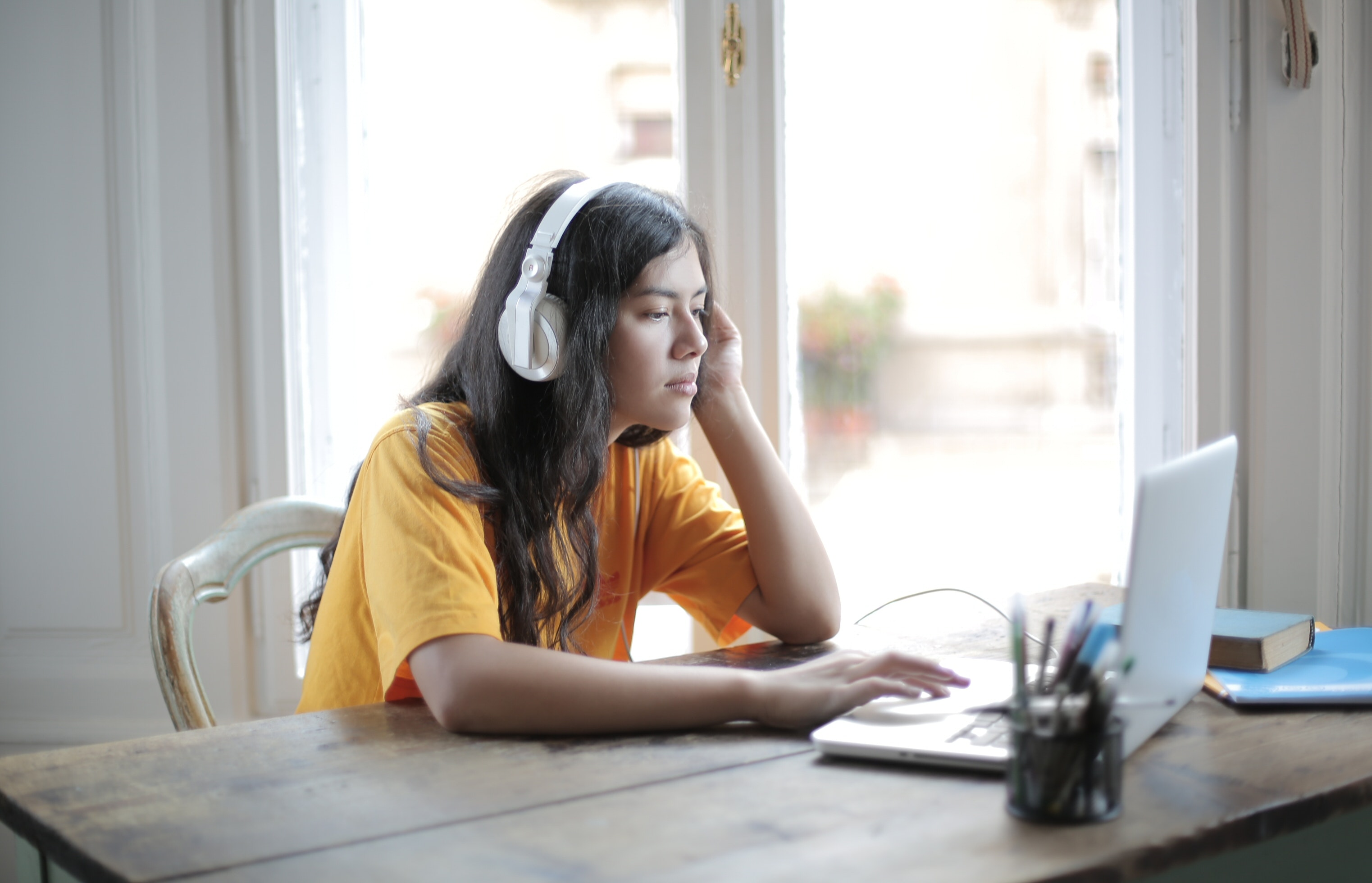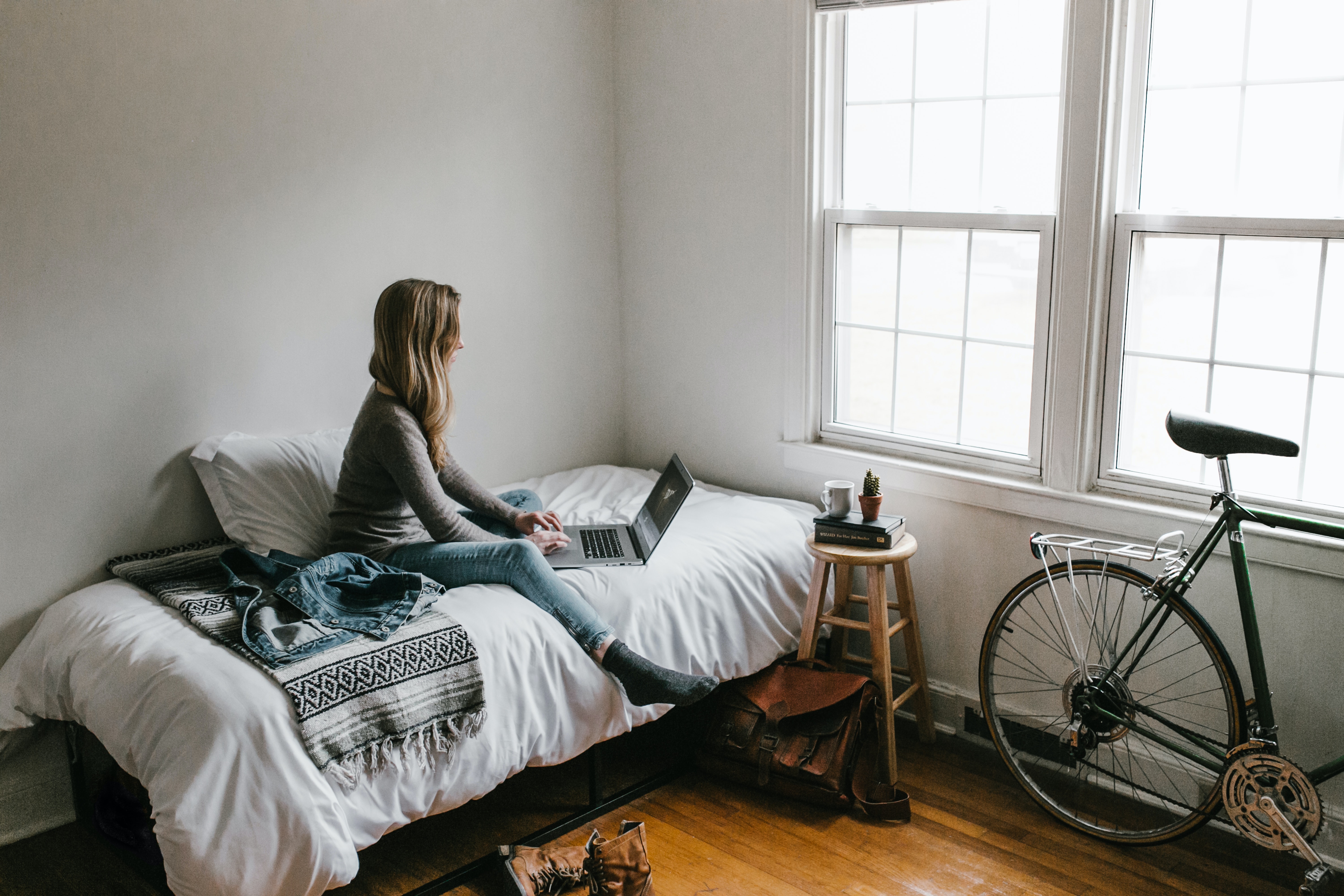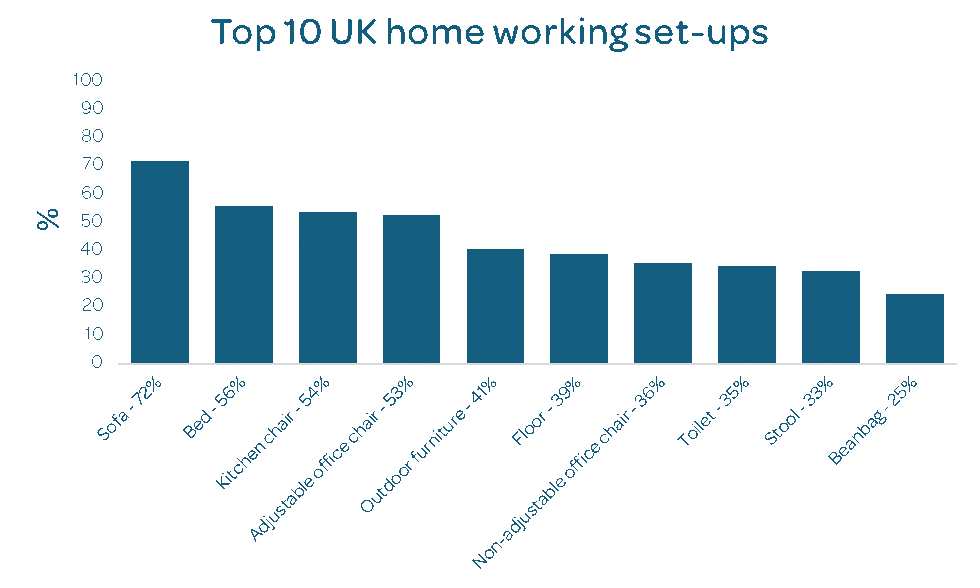Figures from the Office of National Statistics show that, prior to the coronavirus outbreak, only around 5% of the UK’s workforce was mainly home-based - growing at less than one percentage point in the last five years - and only 27% of the workforce had ever worked from home¹.
Yet, in the Government’s 16 March coronavirus briefing, Boris Johnson said that people “should work from home where possible”² and official coronavirus guidance now states that “businesses and workplaces should make every possible effort to enable working from home as a first option”.³
Studies suggest that the UK was one of the least prepared countries to weather a mass home-working strategy⁴ and so, as organisations work to adapt systems, software, processes and communications to continue to deliver their vital services, it is likely that few have yet to find time to ensure employees have an ergonomically sound set-up.
However, Health Safety Executive (HSE) data shows that in 2019 there were 498,000 work-related MSK injuries, leading to 6.9m working days lost and costing businesses £15bn. Many of these were caused by keyboard work, with awkward or tiring positions or repetitive action cited⁵. With the UK workforce suddenly thrown into working from home, in spaces that have not been designed for work, it is likely that many do not have the equipment or knowledge to introduce a set-up that will protect their health and boost productivity.
Government scientists (SAGE) have recommended that the current social distancing measures are upheld for 12 months on-and-off⁶, so it is vitally important that employees are supported to introduce an ergonomically friendly home working set-up as soon as possible. Failing to do so could result in an explosion of MSK injuries that adds extra pressure to individuals, businesses and the health service at what is already the most challenging time of a generation.
A 2019 report by the International Workplace Group found that allowing employees to work from home actually has many benefits to businesses in terms of productivity and reducing costs, yet it said that many were failing to equip employees with the key conditions needed to be successful, such as access to technology and the means to create a professional environment⁷.
Similarly, a HSE guide reminds employers that they have the same responsibility to employees working from home as those in the office⁸ and suggests they carry out workstation assessments for people who are working at home on a long-term basis. They also advise that employees be able to take home items that will help them to achieve a better posture, such as a keyboard, mouse and riser and recommends putting procedures in place to maintain contact, as working from home and away from colleagues can be stressful.
The Government recently announced that MPs would be able to claim £10,000 to cover the cost of home working for them and their staff⁹, but there is currently no provision for the broader UK workforce.
This report provides a snapshot of the make-up of UK home-working under the shadow of Covid-19, revealing the potential health and business impacts and exploring what can be done to protect health at this challenging time.
Are home-workers sitting comfortably?
In April 2020, Ascenti - the UK’s leading physiotherapy group and experts in ergonomics - conducted research of 2,000 people to build a picture of the work-from-home landscape post-Covid-19¹⁰.
The survey was designed to capture important data around people’s home-working set-up, the support they have received from employers and the early signs of any impacts on their physical and mental health.
An explosion of home-working
The survey revealed that half of the UK workforce (48%) have worked from home since the coronavirus outbreak. This is double the number that had ever worked from home prior to Covid-19 and represents a 10-fold increase on the number that were previously based mainly at home.
Access to home-working equipment
Around half of home-workers now cannot access equipment that would have been taken for granted in the workplace, such as an office desk (50%), an adjustable office chair (56%), a separate monitor (55%) and a separate keyboard (51%).
Furthermore, of those with some access, many now have to share this equipment with others in their home. Only 58% have exclusive access to a laptop and only a third can use an office desk (33%) and an adjustable office chair (30%) whenever they choose.
The research shows that this situation is worse for women than for men. Six in 10 women (59%) have no access to an office desk, compared to only four in 10 men (42%). The same trend is seen for other equipment including adjustable office chair, separate monitor, separate mouse, separate keyboard and desk lamp - all of which can have an ergonomic benefit that protects physical health.
Typical home workspace set-up
Worryingly, the sofa is now the UK home-worker’s ‘seat of choice’, with 72% saying they have worked from the sofa since the coronavirus outbreak led to them working from home.
Next is the bed, with 56% of people saying they have carried out work from their mattress and 36% saying they have used their chest as a desk.
Kitchen chairs (54%) are marginally ahead of adjustable office chairs (53%), but more alarming from an ergonomic perspective is the proportion of people who are doing their work from the floor (39%), a stool (33%) and even a beanbag (25%). More than a third of employees (35%) have also been doing work from the toilet.
There is a similar make-do approach to people’s desk options. The most popular desk-option for people in the UK is their lap, with 65% of people using this. And, while six in 10 (58%) may have used an office desk, almost half (47%) have used a coffee table, a third (31%) have made a makeshift table out of boxes and one in four (26%) have used an ironing board.
Young people (aged 16-24) are the most likely to use alternative seating and desk options, with nine out of 10 (91%) working out of bed and half (52%) doing their work from a beanbag. And while men are more likely than women to use an adjustable office chair (58% to 44%), women are more likely than men to base themselves on the sofa (76% to 69%).
These ergonomically damaging set-ups are particularly worrying as more than one in five (22%) home workers report that they are now standing up and moving around less than when they used to be based in the workplace, and a further one in six (17%) say they are working longer hours. Staying fixed in poor seating positions and failing to move around and stretch enough increases the risk of physical injury and can affect mental health too.

Support from employers
Employers have had a tough time trying to adapt their services and systems to meet the unique set of circumstances created by the coronavirus outbreak.
It is understandable therefore that supporting employees to set-up their home workspace has not yet been a priority. Only around one in eight employees (12%) has been given a work-from-home assessment and similarly low numbers have received advice on how to set up their home workspace (15%) and been invited to ask questions about this (17%).
A significant proportion of workers also report that they have not been given access to the equipment they need by their employer. Less than a third (29%) say they have access to the relevant software and programmes they need to do their job effectively and just one in four (28%) have been provided with a work laptop.
Some employers are doing a great job in this area though, with one in six (17%) employees saying they have been provided with office tech equipment such as a mouse, keyboard and monitor, one in 10 (10%) receiving supportive furniture such as an adjustable office chair and one in 10 (10%) being granted funds to purchase the things they need for an ergonomically healthy home workspace.
Early signs of a rise in MSK injuries
Unfortunately, we are already starting to see the impact of home working on people’s physical and mental health.
One in two people (49%) say they are experiencing more physical pain since they started working from home. Around one in five have had more back pain (19%), neck pain (18%) and tightness in their shoulders or elbows (18%), one in four (23%) have had strained or tired eyes and one in seven (15%) have experienced more pain in their hands, fingers or wrists.
With women more likely to have a workspace that is not ergonomically sound, it is perhaps unsurprising that a higher proportion are experiencing pain in all of these areas.

The home-working set-up is also having an emotional impact on people. One in four home-workers (25%) say they feel distant from their colleagues, one in five (22%) struggle to switch off at the end of the day and the same proportion find it hard to concentrate due to the people and pets in their house, while one in seven (14%) are feeling stressed at their workload. The survey found that women are also struggling more than men with these emotional impacts.
The opportunity for the employer brand
Employers that support staff to introduce an ergonomically healthy set-up at home won’t just increase motivation, wellbeing and productivity among their employees, they will also become more attractive as an employer - which will help them with their recruitment and retention for a long-time to come.
More than eight of 10 home workers (85%) say that some of the measures being taken by brands to support staff with home working would make them more likely to want to work for that company.
One in four said they would favour an employer that ensured access to all relevant programmes for working from home (26%) and that provided a work computer/laptop (25%), while one in five would prefer an employer that gave them free office equipment (22%) and office furniture (21%).
It appears that flexibility and understanding are also particularly important to employees at this time. One in four workers (28%) said that they would want to work for a company that recognises that they have other responsibilities in the home besides work and a similar proportion (26%) would be attracted by the promise of work-from-home options in the future.
The recognition that people have other responsibilities within the home was particularly important to female employees, while young people were the most likely to value information and advice on how to set-up a healthy home office.

Taking steps to improve employee health
In order to protect the health of the UK workforce, there needs to be an element of team working between employers, individuals and perhaps the government, to provide an ergonomically healthy home working set-up.
This set-up must empower home-workers with the equipment, advice and understanding they need to manage their physical and mental health at this challenging time, for the benefit of all.
a) Providing the right equipment
It is important that all employees that are not in furlough are given access to the equipment and tools they need to do their job effectively.
Laptops or desktop computers should be provided to those that don’t have access and these should be equipped with the software and programmes that the employee uses.
Office equipment that is not in use for businesses, such as adjustable office chairs, computer screens, keyboards and mice, could potentially be made available to employees in a safe way.
Organisations that have sufficient funding and that plan to maintain a higher level of working from home for the long-term could explore the possibility of providing grants to employees to set-up a comfortable home working space.
The Government could also review the benefits of making funds available - to businesses or individuals - to aid the set-up of healthy home-working across the country, in the way that it has done for MPs.

b) Assessing the workspace
Where feasible, businesses should explore the possibility of conducting work-from-home videocall assessments with employees and offering best practice advice to improve their set-ups. Physiotherapists are well-qualified to support this for organisations that are open to working with expert clinicians.
Employees should be encouraged to set-up a dedicated workspace. Working from the sofa or bed can put a real strain on your body and lead to aches, pains and injury further down the road, especially if done regularly.
The seat they use should be comfortable, at a good height and support their back. An adjustable office chair is preferred, but if not available then they should choose the chair in their home that provides best support.
There are a number of cheats they can use to mirror the benefits of a good chair, for example a rolled up towel against their back can provide lumbar support, sitting on a cushion can increase comfort and adjust height and a footrest can be used if their feet are off the ground.
The top of their monitor should be in-line with their eyes, and their keyboard, mouse and any other necessary devices should be within easy reach.
There should be a good source of natural light and/or access to an effective lamp. Ideally they will have a dedicated area of their home to work in that is free from noise and distractions.
c) Encouraging good posture and movement
Good posture is important and employees should be encouraged to sit upright with their back and neck straight, their knees in-line with their hips at a 90-degree angle and their feet flat on the floor, in-line with their knees.
Employees should be encouraged to think about posture frequently while building positive habits - they should try to avoid crossing their legs if they can and should also be reminded that overreaching for things is a common cause of injury.
If a role requires telephone use for long periods - which could be common now that employees are geographically dispersed - then suggest adaptations such as hands-free headsets.
Regular movement is vital for both the body and mind and employees should be advised not to spend long periods sitting still. Standing up every 20 minutes and moving for just 20 seconds will really help.
There are a large number of physiotherapy exercises and stretches that can help prevent and relieve pains in the back, neck, shoulders and other parts of the body too.
Employees can be encouraged to walk daily for 30-60 minutes, to help them stay fit and unwind. Doing this at the end of the working day can help some people to switch off and separate work life from home life, which can have mental health benefits.
d) Providing clear open communications channels
At this time when employees might be feeling anxious about current events and distant from their colleagues, it is vital that employers create open communication channels and demonstrate understanding of any challenges their staff are facing.
Efforts should also be made to maintain company culture and employee camaraderie. Video calls are a good way for employees to stay connected and many teams are demonstrating togetherness by taking part in social media challenges such as sharing images of their work-from-home set-ups and holding virtual quizzes and get-togethers.
Demonstrating understanding of the challenges employees are facing will strengthen their bond with the organisation and enable them to come forward with any questions about their home working set-up or other aspects of their work.
This will help to protect their physical and mental health, increase productivity and maintain morale during this challenging time. Employees should be reminded of your Employee Assistance Programme (EAP), if you have one, or can be directed to mental health resources from charities including Mind or the Mental Health Foundation.
About Ascenti
Ascenti is the leading independent provider of physiotherapy and selected clinical outsourcing services in the UK. They are a trusted partner to more than 20 NHS Clinical Commissioning Groups (CCGs) and 400 private businesses across the UK, serving NHS patients, pay as you go customers and private medical insurance members.
With extensive national coverage, Ascenti has over 300 highly trained physiotherapists delivering upwards of 600,000 treatment sessions annually. Enabling people to make headway after illness and injury, step back in to work after accidents, or simply stay active and keep moving forward in their daily lives.
Ascenti is a dynamic and progressive company – advancing physical therapies by making them more accessible to all, raising standards and pioneering new digitally enabled physiotherapy and musculoskeletal (MSK) services.
Ascenti is supporting the community during the coronavirus outbreak by providing free online physiotherapy appointments to NHS workers and people over the age of 65. It is also using its ergonomics expertise to provide ‘home-working health checks’ for people who want to ensure they have a good ergonomic set-up.
References
1. https://www.ons.gov.uk/employmentandlabourmarket/peopleinwork/employmentandemployeetypes/articles/coronavirusandhomeworkingintheuklabourmarket/2019
2. https://www.bbc.co.uk/news/uk-51917562
3. https://www.gov.uk/government/publications/guidance-to-employers-and-businesses-about-covid-19/guidance-for-employers-and-businesses-on-coronavirus-covid-19
4. https://www.fmj.co.uk/coronavirus-the-uk-is-not-prepared-for-home-working-according-to-research/
5. https://www.hse.gov.uk/statistics/overall/hssh1819.pdf
6. https://assets.publishing.service.gov.uk/government/uploads/system/uploads/attachment_data/file/873729/06-spi-m-o-consensus-view-on-behavioural-and-social-interventions.pdf
7. http://assets.regus.com/pdfs/iwg-workplace-survey/iwg-workplace-survey-2019.pdf
8. https://www.hse.gov.uk/toolbox/workers/home.htm
9. https://www.bbc.co.uk/news/uk-politics-52231592
10. The survey of a nationally representative UK sample of 2,000 people was conducted through the reputable research company, Censuswide, in April 2020. A total of eight questions were asked and data was broken down by age, gender and location.
